Essential Pantry Organization Supplies for Every Kitchen
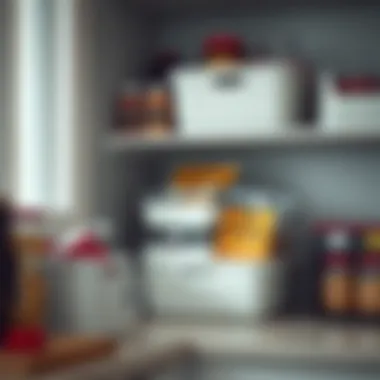
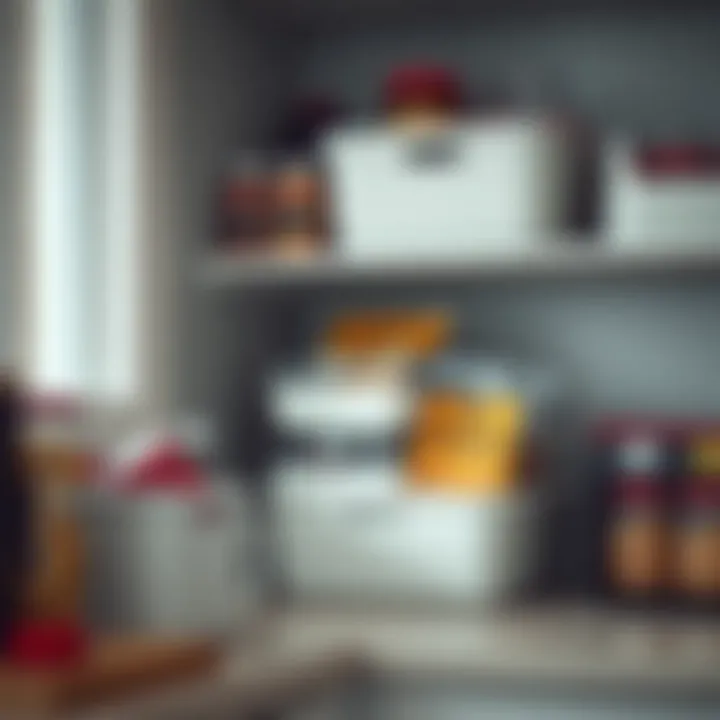
Intro
In the realm of home organization, the pantry often becomes an afterthought, tucked away behind closed doors. Yet, this space serves as the heart of our kitchens, housing everything from canned tomatoes to obscure spices that can transform a meal. Understanding how to effectively organize your pantry can turn a chaotic jumble into a system that flows seamlessly. This guide takes a deep dive into the indispensable supplies available for pantry organization, ensuring that anyone – whether you're whipping up a basic dinner or crafting a culinary masterpiece – can work efficiently and comfortably.
Pantry organization isn't just about tidiness; it’s about creating an environment where every ingredient is at your fingertips. Imagine opening that pantry door and having reach for a jar of cinnamon without having to dig through stacks of boxes to find it. It’s freeing and practically a game-changer for anyone who finds themselves in the kitchen often.
The following sections will explore various types of organizing tools, and how you can choose the right ones to suit your needs. We'll also cover aesthetic aspects, because who says functionality can't come hand in hand with style? By the end of this journey, you’ll not only have a more organized pantry but one that reflects your culinary style as well.
Key Points to Discuss
- The importance of pantry organization and its impact on cooking
- Types of supplies available for organizing
- Tips for selecting and using these tools effectively
- Enhancing the visual appeal of your pantry
With tools and tips at your disposal, let’s delve deeper into the world of pantry organization supplies.
Understanding Pantry Organization
Creating an organized pantry does more than just elevate the visual appeal of your cooking space; it lays the groundwork for more effective meal preparation. An organized pantry sets the stage for ease of access and efficient use of ingredients. Now, before diving into the specifics of how to achieve this, it's crucial to define what we mean by pantry organization and to recognize its significance.
Defining Pantry Organization
Pantry organization refers to the systematic arrangement of food items, cookware, and kitchen supplies to ensure that everything is accessible and easy to find. It involves categorizing items, utilizing appropriate storage solutions, and maintaining order to facilitate quick and efficient meal preparation. Imagine opening a pantry and immediately seeing all your pasta, canned goods, and spices clearly displayed—this level of organization can save you time and reduce stress during cooking sessions.
A well-organized pantry is a reflection of thoughtful planning. It's not just about cramming items onto shelves but rather about mindful curation based on your cooking habits and preferences. For instance, placing often-used items at eye level allows for easier access while keeping less frequently used products tucked away in less accessible spots. By taking the time to define this process, you'll likely find your cooking routines improving quite significantly.
Benefits of an Organized Pantry
The benefits of an organized pantry extend beyond the aesthetic. Here are several advantages that accompany a well-arranged space:
- Time-Saving: Knowing exactly where your ingredients are can streamline the cooking process. This means less time spent rummaging around looking for that elusive can of beans.
- Waste Reduction: An organized pantry helps in keeping track of expiration dates, ensuring that food does not go to waste. When everything is clearly visible, you'll use items before they expire.
- Improved Creativity: When your ingredients are neatly arranged, it becomes easier to mix and match them, encouraging culinary experimentation. A well-ordered pantry offers inspiration with its visual layout.
- Efficient Shopping Practices: Regularly assessing what you have prevents forgetfulness during grocery trips. By knowing what's in your pantry, you can avoid duplicate purchases and reduce unnecessary spending.
- Stress Reduction: An orderly pantry lessens the chaos often associated with meal prep. Knowing where to find your ingredients creates a more pleasant cooking environment.
A well-organized pantry can transform tedious tasks into a pleasant experience, turning cooking from a chore into an enjoyable adventure.
By clearly defining pantry organization and acknowledging its benefits, you set the stage for implementing effective organizing supplies and strategies. As we delve deeper into specific supplies and techniques in the next sections, remember that the ultimate aim is to enhance not only the function of your pantry but also the joy of cooking.
Essential Pantry Supplies
When it comes to creating an organized pantry, having essential pantry supplies at your disposal is paramount. These items not only help streamline your cooking process but also enhance the visual appeal of your pantry. A well-organized pantry reduces clutter, saves time, and ensures that you can quickly find exactly what you need when hunger strikes or when hosting get-togethers.
In this section, we will explore fundamental supplies that can elevate your pantry's functionality and efficiency. By investing in the right tools, you can create a space that is not just functional, but a pleasure to work in. Let’s dive into some key elements.
Shelving Options
Shelving serves as the backbone of any pantry's organization. The right type of shelving can greatly influence both the accessibility and aesthetic quality of your pantry. Consideration of both height and weight capacity is important:
- Adjustable Shelves: These are a must-have. They can be moved up or down to cater to different types of items, from tall jars of pasta to small spice containers.
- Corner Shelves: Often overlooked, corner shelves can make good use of otherwise wasted space. They can hold smaller items like oils or vinegars.
- Open Shelves: These make items visible and easy to access. Plus, they allow you to showcase nice jars or baskets, adding a decorative touch.
Choosing the right shelving can transform your pantry from a chaotic nook into a well-structured haven for cooking needs.
Storage Bins and Containers
Having the right bins and containers is essential for keeping everything from snacks to baking supplies organized and easily accessible. The right choices not only eliminate clutter but also help preserve the quality of your food:
- Clear Plastic Bins: These are great for visibility, allowing you to see contents at a glance. They work well for storing grains, pasta, and snacks.
- Glass Containers: These options offer the benefit of being environmentally friendly and visually attractive. Storing dry goods in glass jars helps maintain freshness and protects against pests.
- Stackable Bins: Consider stackable containers to maximize vertical space. They can free up valuable shelf space, making your pantry more functional.
Investing in quality storage options will not only help in organizing your pantry but will also ensure that food remains fresh and ready for use whenever you need it.
Labels and Markers
Labels are the unsung heroes of pantry organization. A simple tag can make a world of difference in maintaining order:
- Label Makers: If you prefer a clean and uniform appearance, a label maker can provide lasting and professional results.
- Handwritten Labels: For a personal touch, you can craft handwritten labels using recycled materials.
- Chalkboard Labels: They can be reused and customized as needed. Simply wipe off the old label and write a new one—perfect for bins that have different contents over time.
The goal is to ensure that every member of the household knows where things belong, making it easy for everyone to contribute to maintaining the organized space.
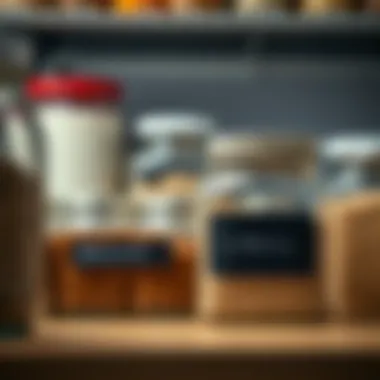

A well-labeled pantry is a key to quickly finding what you need and reducing time spent in the kitchen.
In summary, carefully considering essential pantry supplies is crucial. From versatile shelving options and durable storage bins to effective labeling techniques, each component plays a vital role in creating a pantry that is not only efficient but also visually pleasing. Thus, when setting up your pantry, make sure to choose supplies that cater to your specific needs and preferences.
Types of Containers
When that kitchen pantry is in disarray, it can feel like trying to find a needle in a haystack. That's where the right containers step in, making a world of difference. Selecting appropriate containers isn't just about looks; it’s about enhancing functionality as well. The types of containers you choose can affect everything from accessibility to longevity of food items.
In this discussion, we’ll dive into three main categories: glass jars, plastic storage bins, and metal canisters. Each type has its own strengths, and understanding these can help you make more informed choices based on your cooking habits, food preferences, and personal style.
Glass Jars
Glass jars have been around since forever, eh? They provide a transparent view, allowing you to see what's inside with just a glance. Not only are they versatile, but they’re also sustainable, as they can be reused over and over again. For preserving dry goods like pasta, rice, or spices, glass jars offer an airtight seal which helps whisk away moisture, ensuring the freshness of contents remains intact.
Moreover, they come in various sizes—small jars for herbs and spices or larger ones for grains. Their aesthetic often lends a rustic charm to any pantry. Looking to add a pop of personality? Try labeling them creatively; it’s both functional and decorative. Also, using glass can help you avoid the chemicals that are sometimes found in plastics, making them a healthier option.
Plastic Storage Bins
Plastic storage bins are like the trusty sidekick in the world of pantry organization. They’re lightweight, durable, and often stackable, which makes maximizing space a breeze. When you’re dealing with bulk items—like flour from that mega-bag you bought—plastic bins can be quite handy. They protect contents from pests and moisture effectively.
However, not all plastics are created equal. Choosing high-quality, BPA-free containers is important, especially if you’re storing food. Look for bins with clear labels for easy identification; the last thing you want is to be mixing up sugar with salt. When it comes to cleaning, these bins make it simple too; just toss them in the sink or wipe them down. They truly embody practicality without sacrificing efficiency.
Metal Canisters
The charm of metal canisters often lies in their durability and style. They exude an industrial aesthetic and often come with tight-fitting lids that can keep contents fresh and safe from pests. Think about those beautiful coffee beans you want to keep away from light and moisture; metal canisters do just that!
Metal is generally more robust than both glass and plastic, but it can also be heavier. So if you're planning on storing them on higher shelves, that’s something to ponder. They can be great for longer-term storage situations too. Whether it's screws and nuts, or flour or salt, they can handle it. Add to that the fact that many metal canisters come with appealing designs, and they might just turn into a conversation piece.
"Choosing the right container is not just about keeping things tidy; it's about enhancing the overall efficiency of your culinary environment."
In summary, the types of containers you choose for your pantry can have a significant impact on organization and accessibility. By leveraging the strengths of glass jars, plastic storage bins, and metal canisters, you can cultivate a well-structured space that not only looks good but also supports your cooking endeavors. Choosing wisely means ensuring your efforts in the kitchen do not go unnoticed!
Optimizing Vertical Space
In many kitchens, the pantry is often the unsung hero. It holds all the essentials yet can easily turn into a chaotic mess if not organized properly. One fundamental strategy to tackle this is by optimizing vertical space. This practice is crucial because many pantries have ample height that remains untapped. Maximizing this vertical real estate not only enhances storage capacity but also boosts accessibility and overall organization.
By utilizing the height of your shelves effectively, you can store more items and avoid clutter on countertops. Additionally, stacking items vertically helps in keeping your pantry functional and visually appealing. There's a certain satisfaction in seeing everything neatly arranged, creating both a sense of order and ease when cooking or preparing meals.
Use of Stackable Containers
Stackable containers are a game-changer when it comes to pantry organization. They come in various shapes and sizes, making them adaptable to any space. The beauty of stackable containers is their ability to create layers of storage without taking up extra floor space.
Imagine two or three of these containers stacked on top of one another, filled with grains, pasta, or snacks. You’re using the height of your pantry rather than spreading everything out wide—saving precious shelf space. A big plus? They are often designed to be clear or semi-transparent so that you can quickly see what's inside, helping you avoid unnecessary shopping trips.
- Benefits of Stackable Containers:
- Maximizes vertical storage, increasing overall capacity.
- Keeps items organized and visible, reducing clutter.
- Makes cleaning easier since you can pull out one stack at a time.
Before purchasing, take a moment to measure your shelf height and consider which items you'll store in these containers to ensure a seamless fit.
Incorporating Shelf Risers
Shelf risers are another smart tool for utilizing vertical space in your pantry. These nifty devices elevate items, making it possible to see what's stored on lower shelves without having to crouch or awkwardly reach back.
By incorporating shelf risers, you can instantly transform a cramped shelf into a multi-tiered display. They’re great for canned goods, spices, or even smaller containers that might otherwise get lost at the back of the shelf. The accessibility gained by using shelf risers not only saves time when cooking but also helps prevent duplicates in shopping—keeping an eye on what's available at all times.
"When everything is organized vertically, it feels like you have doubled your storage without the need for expansion."
When choosing shelf risers, consider different materials such as plastic, wood, or metal, based on your pantry style and personal preference. Properly incorporating these tools turns a typical pantry into a well-oiled culinary machine.
Maximizing Accessibility
Accessibility in pantry organization is paramount. It goes beyond mere convenience; it’s about efficiency in daily routines and minimizing the time spent hunting for ingredients. When a pantry is organized with accessibility in mind, everything has its place, allowing you to locate items quickly and effortlessly. This not only saves time but also enhances your cooking experience, making meal preparation smoother than a buttered biscuit.


Pull-Out Drawers and Baskets
Pull-out drawers are a game changer in enhancing pantry accessibility. They allow deep shelves to become user-friendly by bringing contents right to you. Imagine reaching into the back of a dark corner only to find an expired bag of flour gathering dust. With pull-out drawers, those days are behind you. These drawers can accommodate a variety of items, from canned goods to snacks, helping you to visually manage your supplies.
Benefits of Pull-Out Drawers:
- Easy Access: Simply pull the drawer, and voilà! No more odd yoga positions trying to grab that stubborn box of pasta at the back.
- Maximized Space: They utilize depth effectively, allowing you to store a larger quantity without the typical clutter.
- Visibility: Keeping items out in open sight makes it easier to know when you’re running low on eggs or that elusive spice you swear you bought.
Incorporating baskets as a storage solution also promotes accessibility. Baskets can serve multiple functions, from storing bulk items to grouping like items together. The beauty of baskets is their flexibility; you can pull one out, check contents, and then return it all in a breeze.
Tiered Organizers
Tiered organizers are another stellar addition that maximizes accessibility. Think of them like stadium seating for your pantry. Different tiers mean you can see everything without having to play a game of pantry Jenga when searching for that one specific item. With tiered organizers, you can neatly line up spices, condiments, or any small items that typically get lost on a flat shelf.
Advantages of Tiered Organizers:
- Improved Visibility: Items at varying heights allow you to quickly scan what you have, making decision-making easier.
- Space Efficiency: They fit more in less space, so if room is tight, tiered organizers can be a real lifesaver.
- Customizable: Many tiered organizers are adjustable, enabling you to modify them based on your unique pantry dimensions and needs.
"Good organization is the foundation of efficiency. When everything is at your fingertips, you not only save time but you can cook with greater ease and enjoyment."
In closing, maximizing accessibility transforms a cluttered pantry into a functional and enjoyable space. The right combination of pull-out drawers and tiered organizers will ensure that every item in your pantry is easy to access and neatly displayed, helping you whip up meals like a master chef, even on a hectic weeknight.
Establishing a System
Setting up an effective system in your pantry is like laying the groundwork for a well-oiled machine. Without a well-defined framework, even the best organization supplies can fall flat, leading to the same chaotic mess you started with. The importance of establishing a structure lies in enhancing both functionality and efficiency. It allows you to easily locate items, minimizes food waste, and ultimately streamlines your culinary endeavors.
Categorizing Pantry Items
When it comes to categorizing pantry items, the process mirrors organizing your closet—it’s about grouping similar items together. This method invites clarity into your pantry space. For instance, you might consider sorting your items based on their function or food type. Here’s a look at how you could group things:
- Baking Supplies: Store flour, sugar, and baking soda together.
- Canned Goods: Group soups, vegetables, and fruits for easy access.
- Dry Goods: Keep pasta, rice, and legumes in one section.
- Snacks: Allocate a space specifically for chips, granola bars, and nuts.
Choosing a categorization method provides focus and functionality, making restocking items a breeze. Moreover, when someone in the household–be it a partner or a child–needs to grab something, they won’t be left searching in a muddle. They already know where to look.
Creating Zones for Different Items
Creating designated zones in your pantry is akin to zoning a district in a city. Each zone serves a distinct purpose, helping you to manage your pantry items better. This approach creates an intuitive layout making it easier for anyone to navigate the space.
For effective zones:
- Breakfast Corner: Store cereals, jams, and teas. This invites a speedy breakfast prep.
- Cooking Zone: Keep oils, spices, and sauces close at hand for whip-up meals.
- Baking Section: Have baking sheets, sprinkles, and flavor extracts all stored together.
Here’s the crux: when everything has its place, it fosters not only efficiency but also enhances the usability of the pantry. When everyone knows where what belongs, chores become less of a hassle.
Even with a helping hand from clever organizing supplies, remember to periodically shuffle items as per usage. The key isn’t just to set it and forget it, but to adapt the system over time for maximum benefit.
"An organized pantry is not just visually appealing; it is a hallmark of culinary efficiency."
By paying special attention to how you categorize and zone your pantry, you pave the way for a seamless cooking experience, elevating not just the space, but ultimately the meals you prepare.
Incorporating Aesthetic Elements
In the realm of pantry organization, functionality often takes the forefront in our planning. However, to overlook the aesthetic elements is to miss a crucial opportunity to enhance your culinary space. An organized pantry that pleases the eye can elevate your kitchen atmosphere, creating an inviting environment conducive to meal prep and family gatherings. It’s essential to consider how color, style, and decor interplay within your pantry, merging practicality with personal flair.
Color Coordination
Color is a powerful tool in setting the mood and atmosphere of any space, and your pantry is no exception. Employing a cohesive color palette not only aids in creating visual harmony but also simplifies navigation through your pantry's contents. Choose a primary color that resonates with your kitchen’s overall theme, and let that guide your selections of containers and shelving. For instance, if your kitchen leans toward warm tones, consider terracotta or sandy shades for your storage solutions.
Utilizing various shades within the same color family can also create depth. For example, imagine a spacing adorned in pale sage green jars alongside deeper forest green canisters. This layered color scheme offers a sophisticated look without overwhelming the space.
Another tip to keep in mind is to categorize items by color. Here’s how:
- Pasta: Use neutral or beige containers for a rustic feel.
- Snacks: Brightly colored bins can add a whimsical touch, drawing attention to fun treats.
- Spices: Small glass jars with labels can exhibit symmetry and elegance, while their contents reveal compelling hues.
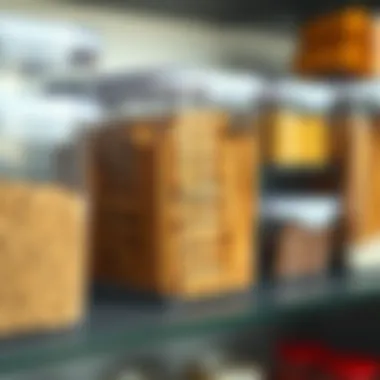
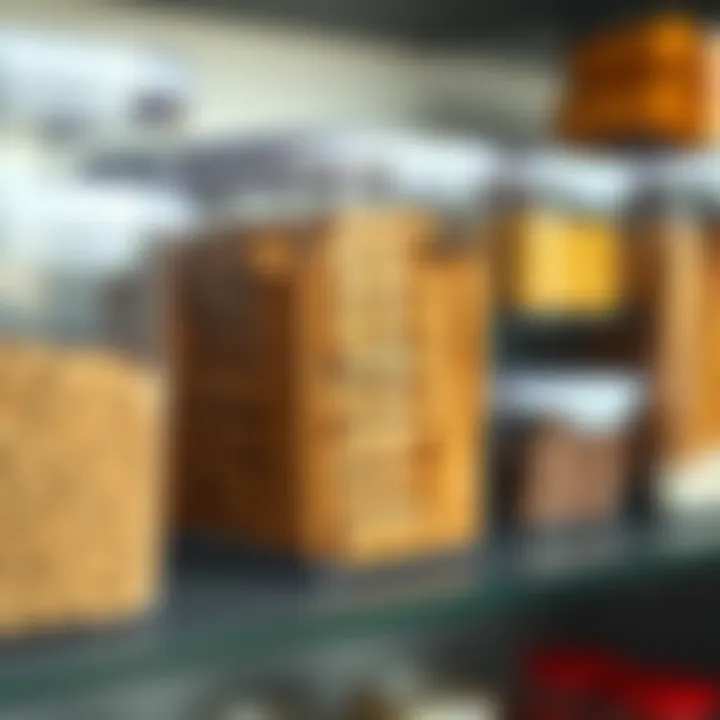
Notably, don’t shy away from using wrapping paper or contact paper in various colors for shelving, adding a splash of personality that is easily changeable for seasonal vibes. The trick here is to balance aesthetics with practicality, as overly complex arrangements might deter efficiency despite their visual appeal.
Decorative Storage Solutions
Decorative storage solutions do more than just keep your pantry neat; they tell a story about your culinary passions and lifestyle. Consider incorporating unique objects that blend utility with art. For instance, vintage crates can serve as stylish displays while also housing produce or canned goods. These kinds of elements deliver character to an otherwise utilitarian space.
Another approach can be the use of decorative glass jars and canisters. Not only do they protect your ingredients, but they transform your pantry items into an accessible showcase. Even something as simple as a hanging herb garden can infuse life into the pantry walls, providing fresh ingredients while enhancing the visual appeal.
Don’t forget about labels. While they are practical, well-designed labels can also serve an aesthetic function. Opt for a consistent font and design to maintain the overall aesthetic of your space. Additionally, consider creating a gallery wall with framed artwork or even your favorite recipes, making the pantry not just a storage area, but a source of inspiration as well.
"A pantry is more than just a space for food; it’s a canvas for creativity and a reflection of personal style."
In merging functionality with aesthetic appeal, one must always remember the balance. Your pantry can and should reflect your tastes while remaining a place where finding and retrieving items is seamless and effortless. Choosing the right decorative elements can make your pantry a cherished component of your kitchen instead of merely a storage solution.
Maintaining an Organized Pantry
An organized pantry isn’t just a matter of aesthetics; it plays a critical role in the overall efficiency of your kitchen. Having clarity in how your pantry is arranged makes cooking and meal prep much simpler. When you can easily find what you need, you save time and reduce stress.
However, achieving and maintaining that level of organization requires ongoing effort. Just like a well-tended garden, your pantry thrives with regular care. You risk chaos and wasted resources if you let it fall into disarray. This section explores the essentials of maintaining an organized pantry, focusing on methods that ensure both functionality and longevity.
Regular Inventory Checks
Performing regular inventory checks is the backbone of pantry maintenance. This encompasses not only checking what you have but also assessing its condition and usability. Each time you dive into your pantry, take a moment to survey the contents and evaluate.
- Keep Track: Make a checklist of all items and their expiration dates. This helps you notice items that are about to expire or anything you are running low on.
- Use a Spreadsheet or App: In this digital age, utilizing a simple spreadsheet or an inventory app can make this task much easier. Applications like Out of Milk can help streamline the process, allowing you to check items off as you use them.
- Plan Your Meals: Regular inventory checks synchronize well with your meal planning. Knowing what you have can inspire new dish ideas. It often leads to the realization that you don’t need to buy more groceries, saving both time and money.
By staying on top of your pantry contents, you ensure you are using what you have before it spoils, leading to less waste and maximizing your ingredients.
Setting Up a Rotation System
Introducing a rotation system into your pantry organization is another great way to maintain order. This practice not only helps in minimizing waste but also ensures that older items are used before newer ones. Here’s how to implement it effectively:
- First In, First Out (FIFO): Always place the newest purchases at the back and older items at the front. This is a classic method that encourages you to grab the items you've had the longest first.
- Label & Date: Clearly marking dates on items can streamline this process. Use bold labels or sticky notes to alert you to the purchase date or expiration date.
- Dedicated Zones: Designate specific areas within your pantry for certain categories of foods, like canned goods or grains. By grouping similar items together, it becomes easier to spot what needs to be used.
Setting up a rotation system can feel tedious at first, but over time, it pays dividends. Not only will your pantry maintain its organization, but you will also create a habit that supports sustainable consumption and less food wastage.
"A cluttered pantry can cloud your culinary creativity. Keeping it organized sharpens your kitchen game."
Sustainable Pantry Practices
Sustainability in pantry organization practices isn't just a trend anymore; it's a necessity. As people become more conscious of their environmental impact, the way we organize our food storage spaces is changing dramatically. Implementing sustainable pantry practices can lead to numerous benefits, satisfying not just the eco-conscious mindset but also enhancing the functionality and aesthetic of your kitchen.
When we talk about sustainability, it generally involves using resources in a way that doesn't deplete them and protects the environment for future generations. In the context of pantry organization, this can mean opting for materials that are recyclable, reusable, or composed of renewable resources. It also encompasses practices aimed at minimizing waste, whether through smarter purchasing decisions or efficient food usage.
Here are a few specific elements to consider:
- Material Choices: Look for storage solutions made from sustainable materials. For example, select glass containers or bamboo baskets over plastic. Glass is not only reusable but also doesn’t leach harmful chemicals into food.
- Durability: Investing in sturdy, lasting products is crucial. Products that wear out quickly must be replaced frequently, leading to more waste. Consider stainless steel containers or high-quality jars that can withstand the test of time.
- Local Sources: Buying your storage items from local artisans or businesses reduces carbon footprints associated with transportation.
The positive aspects of these practices are manifold. They contribute to a cleaner planet and can also save you money in the long run, as quality items need not be replaced frequently. Integrating eco-friendly habits into pantry organization reflects a commitment to making choices that are good for both you and the environment.
"Every small action counts in the fight for a sustainable future. Your pantry can be a reflection of those efforts."
Eco-Friendly Storage Options
Choosing eco-friendly storage options is an integral part of adopting sustainable pantry practices. Not only do these options reduce environmental harm, they often bring added benefits such as improved food preservation and better management of space. Below are some viable choices:
- Glass Containers: They are perfect for storing grains, pastas, and even snacks. Glass doesn’t absorb odors or stains, making it easy to maintain.
- Bamboo Baskets: These work well for fruits and vegetables. Not only are they stylish, but bamboo is a rapidly renewable resource.
- Compostable Bags: If you need to store items temporarily or have bulk purchases, opt for compostable storage bags. They break down in composting piles and do not contribute to landfill waste.
By selecting these eco-friendly storage solutions, you reduce your carbon footprint while also enjoying a clean and organized pantry space.
Reducing Food Waste
Reducing food waste is often the linchpin of sustainable pantry practices. One of the harsh realities is that a considerable amount of food ends up in landfills, and this not only squanders valuable resources but also contributes to greenhouse gas emissions. To combat this issue, consider these strategies:
- Smart Inventory Management: Keep an eye on what you have. Regularly check expiry dates and familiarize yourself with the "First In, First Out" (FIFO) approach.
- Repurpose Leftovers: Get creative with leftovers instead of tossing them out. Leftover veggies can go into soups, while stale bread can be turned into croutons.
- Meal Planning: By planning meals for the week, you can purchase only what you need and reduce impulse buys that often lead to waste.
Here are some tips to manage food effectively:
- Keep a list of items on hand that need to be used soon.
- Label your containers with dates to track when items should be consumed.
- Share excess food with neighbors or through local food banks.
By implementing these practices, you not only help the environment but can also save yourself some money in groceries.















